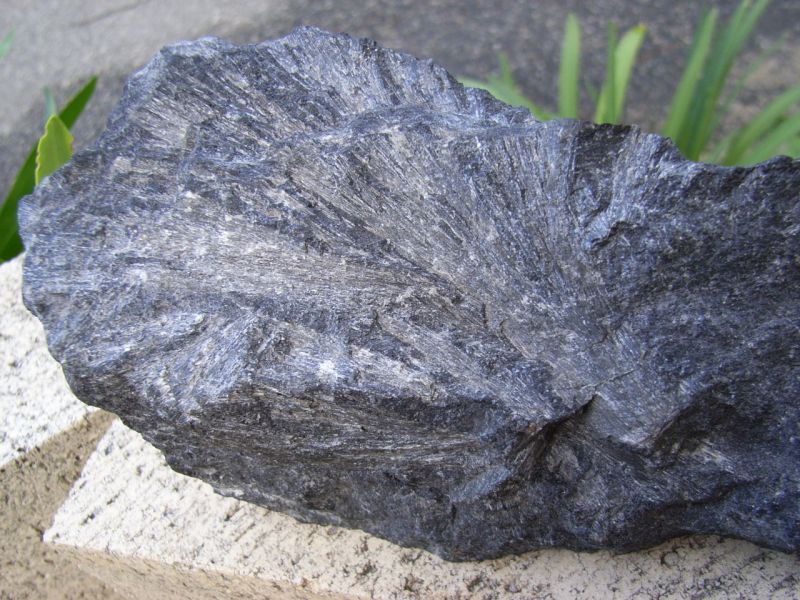|
Chesterite
Chesterite is a rare silicate mineral that can be compared to amphiboles, micas, and jimthompsonite. Its chemical formula is . Chesterite is named after Chester, Vermont, where it was first described in 1977.Konishi, Hiromi, Reijo, Alviola, and Buseck, Peter R. (2004) 2111 biopyribole intermediate between pyroxene and amphibole: Artifact or natural product? American Mineralogist, 89, 15-19. The specific geologic setting within its origin is the Carleton talc quarry in Chester, Vermont. Chesterite has an orthorhombic crystal structure, which means it has three crystallographic axes of unequal length. All of the axes are perpendicular to each other. The stacking sequence for chesterite, which is found in micas, is very similar to orthopyroxenes and orthoamphiboles.Wyckoff, R.W.G. (1968) Crystal Structures (Second edition). 310-314 p. University of Arizona, Tucson, Arizona. Chesterite is an anisotropic mineral; therefore, it allows light to travel through it at different velocit ... [...More Info...] [...Related Items...] OR: [Wikipedia] [Google] [Baidu] |
Jimthompsonite
Jimthompsonite is a magnesium iron silicate mineral with chemical formula . It is a triple chain silicate (or inosilicate) along with clinojimthompsonite and chesterite. They were described in 1977 by Burham and Veblen. They attracted great mineralogical attention because they were the first examples of new chain silicate structures among a large group known as biopyriboles whose name is derived from the words biotite, pyroxene, and amphiboles. James B. Thompson, Jr. postulated the existence of the new biopyroles in 1970. The theory proved correct when jimthompsonite, clinojimthompsonite and chesterite were discovered in the Carlton Quarry in Windsor County, Vermont in 1977. The new minerals are found intergrown with the amphiboles anthophyllite and cummingtonite in sprays up to 5 cm long. They are all colorless to pale pinkish-brown and transparent. As for pyroxene and amphiboles, the type of chain structure dictates the angle between the two distinctive cleavages. The ... [...More Info...] [...Related Items...] OR: [Wikipedia] [Google] [Baidu] |
Inosilicates
Silicate minerals are rock-forming minerals made up of silicate groups. They are the largest and most important class of minerals and make up approximately 90 percent of Earth's crust. In mineralogy, silica (silicon dioxide, ) is usually considered a silicate mineral. Silica is found in nature as the mineral quartz, and its polymorphs. On Earth, a wide variety of silicate minerals occur in an even wider range of combinations as a result of the processes that have been forming and re-working the crust for billions of years. These processes include partial melting, crystallization, fractionation, metamorphism, weathering, and diagenesis. Living organisms also contribute to this geologic cycle. For example, a type of plankton known as diatoms construct their exoskeletons ("frustules") from silica extracted from seawater. The frustules of dead diatoms are a major constituent of deep ocean sediment, and of diatomaceous earth. General structure A silicate mineral is generally an ... [...More Info...] [...Related Items...] OR: [Wikipedia] [Google] [Baidu] |
Orthorhombic
In crystallography, the orthorhombic crystal system is one of the 7 crystal systems. Orthorhombic lattices result from stretching a cubic lattice along two of its orthogonal pairs by two different factors, resulting in a rectangular prism with a rectangular base (''a'' by ''b'') and height (''c''), such that ''a'', ''b'', and ''c'' are distinct. All three bases intersect at 90° angles, so the three lattice vectors remain mutually orthogonal. Bravais lattices There are four orthorhombic Bravais lattices: primitive orthorhombic, base-centered orthorhombic, body-centered orthorhombic, and face-centered orthorhombic. For the base-centered orthorhombic lattice, the primitive cell has the shape of a right rhombic prism;See , row oC, column Primitive, where the cell parameters are given as a1 = a2, α = β = 90° it can be constructed because the two-dimensional centered rectangular base layer can also be described with primitive rhombic axes. Note that the length a of the primit ... [...More Info...] [...Related Items...] OR: [Wikipedia] [Google] [Baidu] |
Silicate Mineral
Silicate minerals are rock-forming minerals made up of silicate groups. They are the largest and most important class of minerals and make up approximately 90 percent of Earth's crust. In mineralogy, silica (silicon dioxide, ) is usually considered a silicate mineral. Silica is found in nature as the mineral quartz, and its polymorphism (materials science), polymorphs. On Earth, a wide variety of silicate minerals occur in an even wider range of combinations as a result of the processes that have been forming and re-working the crust for billions of years. These processes include partial melting, crystallization, fractionation, metamorphism, weathering, and diagenesis. Living organisms also contribute to this carbonate–silicate cycle, geologic cycle. For example, a type of plankton known as diatoms construct their exoskeletons ("frustules") from silica extracted from seawater. The frustules of dead diatoms are a major constituent of deep ocean sediment, and of diatomaceous e ... [...More Info...] [...Related Items...] OR: [Wikipedia] [Google] [Baidu] |
Amphibole
Amphibole () is a group of inosilicate minerals, forming prism or needlelike crystals, composed of double chain tetrahedra, linked at the vertices and generally containing ions of iron and/or magnesium in their structures. Its IMA symbol is Amp. Amphiboles can be green, black, colorless, white, yellow, blue, or brown. The International Mineralogical Association currently classifies amphiboles as a mineral supergroup, within which are two groups and several subgroups. Mineralogy Amphiboles crystallize into two crystal systems, monoclinic and orthorhombic. In chemical composition and general characteristics they are similar to the pyroxenes. The chief differences from pyroxenes are that (i) amphiboles contain essential hydroxyl (OH) or halogen (F, Cl) and (ii) the basic structure is a double chain of tetrahedra (as opposed to the single chain structure of pyroxene). Most apparent, in hand specimens, is that amphiboles form oblique cleavage planes (at around 120 degrees), whe ... [...More Info...] [...Related Items...] OR: [Wikipedia] [Google] [Baidu] |
Mica
Micas ( ) are a group of silicate minerals whose outstanding physical characteristic is that individual mica crystals can easily be split into extremely thin elastic plates. This characteristic is described as perfect basal cleavage. Mica is common in igneous and metamorphic rock and is occasionally found as small flakes in sedimentary rock. It is particularly prominent in many granites, pegmatites, and schists, and "books" (large individual crystals) of mica several feet across have been found in some pegmatites. Micas are used in products such as drywalls, paints, fillers, especially in parts for automobiles, roofing and shingles, as well as in electronics. The mineral is used in cosmetics and food to add "shimmer" or "frost." Properties and structure The mica group is composed of 37 phyllosilicate minerals. All crystallize in the monoclinic system, with a tendency towards pseudohexagonal crystals, and are similar in structure but vary in chemical composition. Micas are ... [...More Info...] [...Related Items...] OR: [Wikipedia] [Google] [Baidu] |
Chester, Vermont
Chester is a town in Windsor County, Vermont, United States. The population was 3,005 at the 2020 census. History The town was originally chartered by New Hampshire Governor Benning Wentworth as Flamstead in 1754. The terms of the charter were not met and the town was re-chartered as New Flamstead in 1761. In 1766, a patent was issued by New York that changed the name of the town to Chester, after George Augustus Frederick, the Earl of Chester and the eldest son of King George III. Later, the governing authority of Chester reverted to the 1761 charter by an act of the Vermont legislature, although it left the name "Chester" in place. 2011 was thus the 250th anniversary of the town. Geography According to the United States Census Bureau, the town has a total area of , of which is land and , or 0.46%, is water. A prominent geological feature of the town is the Williams River, a tributary of the Connecticut River, whose three branches come together as a central river and run thr ... [...More Info...] [...Related Items...] OR: [Wikipedia] [Google] [Baidu] |
Orthorhombic
In crystallography, the orthorhombic crystal system is one of the 7 crystal systems. Orthorhombic lattices result from stretching a cubic lattice along two of its orthogonal pairs by two different factors, resulting in a rectangular prism with a rectangular base (''a'' by ''b'') and height (''c''), such that ''a'', ''b'', and ''c'' are distinct. All three bases intersect at 90° angles, so the three lattice vectors remain mutually orthogonal. Bravais lattices There are four orthorhombic Bravais lattices: primitive orthorhombic, base-centered orthorhombic, body-centered orthorhombic, and face-centered orthorhombic. For the base-centered orthorhombic lattice, the primitive cell has the shape of a right rhombic prism;See , row oC, column Primitive, where the cell parameters are given as a1 = a2, α = β = 90° it can be constructed because the two-dimensional centered rectangular base layer can also be described with primitive rhombic axes. Note that the length a of the primit ... [...More Info...] [...Related Items...] OR: [Wikipedia] [Google] [Baidu] |
Ultramafic
Ultramafic rocks (also referred to as ultrabasic rocks, although the terms are not wholly equivalent) are igneous and meta-igneous rocks with a very low silica content (less than 45%), generally >18% MgO, high FeO, low potassium, and are composed of usually greater than 90% mafic minerals (dark colored, high magnesium and iron content). The Earth's mantle is composed of ultramafic rocks. Ultrabasic is a more inclusive term that includes igneous rocks with low silica content that may not be extremely enriched in Fe and Mg, such as carbonatites and ultrapotassic igneous rocks. Intrusive ultramafic rocks Intrusive ultramafic rocks are often found in large, layered ultramafic intrusions where differentiated rock types often occur in layers. Such cumulate rock types do not represent the chemistry of the magma from which they crystallized. The ultramafic intrusives include the dunites, peridotites and pyroxenites. Other rare varieties include troctolite which has a greater percenta ... [...More Info...] [...Related Items...] OR: [Wikipedia] [Google] [Baidu] |
Polytype
In materials science, polymorphism describes the existence of a solid material in more than one form or crystal structure. Polymorphism is a form of isomerism. Any crystalline material can exhibit the phenomenon. Allotropy refers to polymorphism for chemical elements. Polymorphism is of practical relevance to pharmaceuticals, agrochemicals, pigments, dyestuffs, foods, and explosives. According to IUPAC, a polymorphic transition is "A reversible transition of a solid crystalline phase at a certain temperature and pressure (the inversion point) to another phase of the same chemical composition with a different crystal structure." According to McCrone, polymorphs are "different in crystal structure but identical in the liquid or vapor states." Materials with two polymorphs are called dimorphic, with three polymorphs, trimorphic, etc. Examples Many compounds exhibit polymorphism. It has been claimed that "every compound has different polymorphic forms, and that, in general, the num ... [...More Info...] [...Related Items...] OR: [Wikipedia] [Google] [Baidu] |
Anthophyllite
Anthophyllite is an orthorhombic amphibole mineral: ☐Mg2Mg5Si8O22(OH)2 (☐ is for a vacancy, a point defect in the crystal structure), magnesium iron inosilicate hydroxide. Anthophyllite is polymorphic with cummingtonite. Some forms of anthophyllite are lamellar or fibrous and are classed as asbestos. The name is derived from the Latin word ''anthophyllum'', meaning ''clove'', an allusion to the most common color of the mineral. The Anthophyllite crystal is characterized by its perfect cleavage along directions 126 degrees and 54 degrees. Occurrence Anthophyllite is the product of metamorphism of magnesium-rich rocks, especially ultrabasic igneous rocks and impure dolomitic shales. It also forms as a retrograde product rimming relict orthopyroxenes and olivine, and as an accessory mineral in cordierite-bearing gneisses and schists. Anthophyllite also occurs as a retrograde metamorphic mineral derived from ultramafic rocks along with serpentinite. Occurrence in ultramafic ... [...More Info...] [...Related Items...] OR: [Wikipedia] [Google] [Baidu] |






